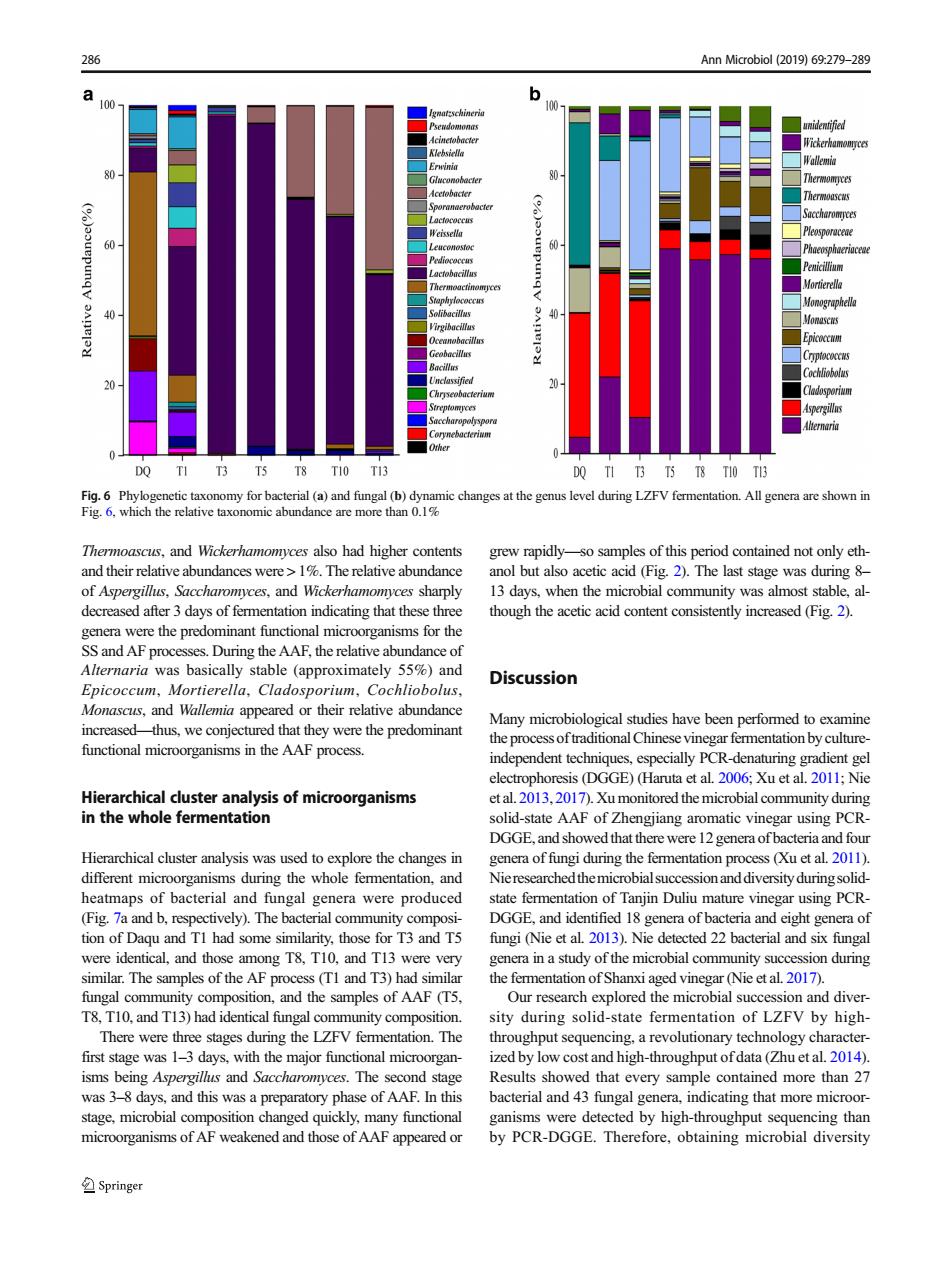正在加载图片...

286 DO 8 T10 DO TI T3 T5 T8 T10 T13 Themoascus and wickerlamonnes also had higher contents grew ranidl-so samnles of this neriod contained not only eth and their relative abundances were>1%.The relative abundance anol but also acetic acid (Fig.2).The last stage was during 8 of Aspergillus,Saccharomyces,and Wickerhamonyces sharply 13 days,when the microbial community was almost stable,al- decreased after 3 days of fermentation indicating that these three though the acetic acid content consistently increased (Fig.2). was basically stable(e roximately 556)and Epicocc Mortere Cladospori Coc Discussion Monascus,and Wallemia appeared or their relative abundance ncreased- thus,we conjectured that they were the predominant functional microorganisms in the AAF process nyc Hierarchical cluster analysis of microorganisms etal.2013.2017).Xu monitored the microbial community during in the whole fermentation solid-state AAF of Zhengjiang aromatic vinegar using PCR. DGGE,and showed that there were 12 genera of bacteria and four ing the whole termentation, gehera were prod an Taniin Duliu adiesinytrmgCR DGGEanddcotfiedi8 tion of Dagu and TI had ome similarity those for and Ts fungi (Nie t al 2013).Nie detected 22 bacterial were identical,and those among T8.T10.and T13 were very genera in a study of the microbial community succession during similar.The samples of the AF process(T1 and T3)had similar the fermentation ofShanxiaged vinegar (Nie etal 2017). d the samples of AAF(T5 Our r lore the L during solid first stage was 3 days.with the t and high thm pout ofdata (2014) isms being aspergillus and The second stag Results showed that every sample contained more than 27 was3-8 days,and this was a preparatory phase of AAF.In this bacterial and 43 fungal genera,indicating that more microor stage,microbial composition changed quickly,many functiona ganisms were detected by high-throughput sequencing than microorganisms of AF weakened and those of AAF appeared or by PCR-DGGE.Therefore,obtaining microbial diversity ≌Springe Thermoascus, and Wickerhamomyces also had higher contents and their relative abundances were > 1%. The relative abundance of Aspergillus, Saccharomyces, and Wickerhamomyces sharply decreased after 3 days of fermentation indicating that these three genera were the predominant functional microorganisms for the SS and AF processes. During the AAF, the relative abundance of Alternaria was basically stable (approximately 55%) and Epicoccum, Mortierella, Cladosporium, Cochliobolus, Monascus, and Wallemia appeared or their relative abundance increased—thus, we conjectured that they were the predominant functional microorganisms in the AAF process. Hierarchical cluster analysis of microorganisms in the whole fermentation Hierarchical cluster analysis was used to explore the changes in different microorganisms during the whole fermentation, and heatmaps of bacterial and fungal genera were produced (Fig. 7a and b, respectively). The bacterial community composition of Daqu and T1 had some similarity, those for T3 and T5 were identical, and those among T8, T10, and T13 were very similar. The samples of the AF process (T1 and T3) had similar fungal community composition, and the samples of AAF (T5, T8, T10, and T13) had identical fungal community composition. There were three stages during the LZFV fermentation. The first stage was 1–3 days, with the major functional microorganisms being Aspergillus and Saccharomyces. The second stage was 3–8 days, and this was a preparatory phase of AAF. In this stage, microbial composition changed quickly, many functional microorganisms of AF weakened and those of AAF appeared or grew rapidly—so samples of this period contained not only ethanol but also acetic acid (Fig. 2). The last stage was during 8– 13 days, when the microbial community was almost stable, although the acetic acid content consistently increased (Fig. 2). Discussion Many microbiological studies have been performed to examine the process oftraditionalChinese vinegar fermentation by cultureindependent techniques, especially PCR-denaturing gradient gel electrophoresis (DGGE) (Haruta et al. 2006; Xu et al. 2011; Nie et al. 2013, 2017). Xu monitored the microbial community during solid-state AAF of Zhengjiang aromatic vinegar using PCRDGGE, and showed that there were 12 genera of bacteria and four genera of fungi during the fermentation process (Xu et al. 2011). Nie researchedthemicrobialsuccessionanddiversityduringsolidstate fermentation of Tanjin Duliu mature vinegar using PCRDGGE, and identified 18 genera of bacteria and eight genera of fungi (Nie et al. 2013). Nie detected 22 bacterial and six fungal genera in a study of the microbial community succession during the fermentation of Shanxi aged vinegar (Nie et al. 2017). Our research explored the microbial succession and diversity during solid-state fermentation of LZFV by highthroughput sequencing, a revolutionary technology characterized by low cost and high-throughput of data (Zhu et al. 2014). Results showed that every sample contained more than 27 bacterial and 43 fungal genera, indicating that more microorganisms were detected by high-throughput sequencing than by PCR-DGGE. Therefore, obtaining microbial diversity Fig. 6 Phylogenetic taxonomy for bacterial (a) and fungal (b) dynamic changes at the genus level during LZFV fermentation. All genera are shown in Fig. 6, which the relative taxonomic abundance are more than 0.1% 286 Ann Microbiol (2019) 69:279–289